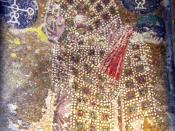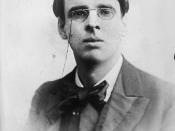The poem "Sailing to Byzantium" is one of the most substantial pieces included in W.B. Yeats's final book "The Tower". Created in the later years of his life, many of the poems in The Tower deal with the issues of old age and leaving the natural world, but none so strongly as "Sailing to Byzantium". Byzantium itself symbolized eternity to Yeats; it was an ancient city that represented a place of artistic and intellectual permanence. Yeats believed that ""in early Byzantium, maybe never before or since in recorded history, religious, aesthetic, and practical life were one, that architects and artificers... spoke to the multitude in gold and silver. The painter, the mosaic worker, the worker in gold and silver, the illuminator of sacred books were almost impersonal, almost perhaps without the consciousness of individual design, absorbed in their subject matter and that the vision of a whole people."
(Yeats 279-280) The eternal existence of both those worlds together, intellect and art together as one without being effected by an aging body and natural surrounding, was something that Yeats desired as an older man (perhaps earlier in life too). "Sailing to Byzantium" is evidence of that main theme that is present in many of the poems in The Tower; the growing contradiction between Yeats aging body and his still youthful mind, and his ideas on the contrast between the constantly fading natural world and the ever constant world of art.
The immediate issue brought forth in the first stanza of the poem is the impermanence of the natural state of the world, and the fact that everything living must one day meet an end. "That is no country for old men" means both Ireland and the natural world in general, where "fish flesh or fowl,


